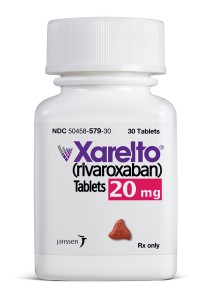FDA Approval of Xarelto May Have Been Based on False Data
Thousands of Xarelto users have brought federal lawsuits against the drug’s manufacturers alleging that the anticoagulant caused uncontrollable bleeding and severe injuries.
Recent reports shed light on a how the drug made it to the market with FDA approval. The anticoagulant’s drug trial was based on what may have been a faulty measurement device, potentially skewing the results.
About Xarelto
Xarelto, manufactured by Johnson & Johnson and Bayer Healthcare, is one of a newer generation of anticoagulants that was released as a head-to-head competitor to warfarin. Approved by the FDA more than half a century ago, warfarin had been the leading anticoagulant but requires close monitoring; a doctor is required to personalize dosing according to factors like a patient’s age and diet.
Xarelto, and similar drugs that include Pradaxa and Eliquis, promised to be a safer alternative that make a doctor’s continual monitoring of the patient unnecessary. But an inherent risk in using a blood thinner is excessive bleeding, and bleeding events with warfarin are easier to control. Warfarin works by slowing vitamin K production and bleeding can be reversed by administering a dose of vitamin K.
Xarelto works in a different fashion and there is no known antidote for the bleeding events they cause.
Trials incorporated recalled device
The FDA approved Xarelto in 2011 to reduce the risk of deep vein thrombosis and pulmonary embolism. Approval was based in part on Xarelto’s clinical trials, known as ROCKET-AF, which compared the rate of blood clotting between Xarelto and warfarin.
A device called INRatio, by Alere, was a crucial piece in the trials; INRatio measured the level of warfarin in a test subject’s blood and adjusted the dosage. But the device was recalled in December 2014 because some units were reporting readings that were artificially low. The malfunction could have had a significant effect on the Xarelto trial; readings that were misreported too low would have resulted in patients on warfarin receiving an excessive does, increasing the chances that they would experience a bleeding event and creating the false impression that Xarelto had a comparatively lower rate of internal bleeding.
The chances that an INRatio malfunction affected the study are good – Alere has received reports of nearly 19,000 malfunctions, with 14 citing serious injuries. Records indicate that the FDA had issued warning letters about INRatio devices before the trial began in 2006.
Widespread impact of Xarelto
Following a growing trend, Xarelto has been heavily marketed directly to consumers with commercials featuring professional actors and athletes. It reached $1.5 billion in U.S. sales last year, having been prescribed to more than 3 million American patients.
Nearly 19,000 people have filed Xarelto lawsuits in federal courts over injuries allegedly caused by excessive bleeding events while taking the medication. The federal cases have been consolidated for pretrial purposes in multidistrict litigation proceeding. The first cases from the proceeding are expected to go to trial in mid-late 2016 and their outcomes will likely set the tone for possible negotiations for the thousands of remaining cases.
- BMJ, Data on trial of anticoagulant is to reanalyzed after discovery that investigators used faulty device, http://www.bmj.com/content/351/bmj.h6431#
- POGO, Drug Problems: Duke Reassessing Data From Trial Led By FDA Nominee, http://www.pogo.org/blog/2015/11/drug-problems-duke-reassessing-data-drug-trial.html
- United States District Court for the Eastern District of Louisiana, MDL – 2592 Xarelto Products Liability Litigation, http://www.laed.uscourts.gov/xarelto/
- FDA, FDA News Release: FDA expands use of Xarelto to treat, reduce recurrence of blood clots, http://www.fda.gov/NewsEvents/Newsroom/PressAnnouncements/ucm326654.htm



 Resources
Resources
 Resources
Resources
